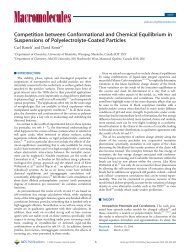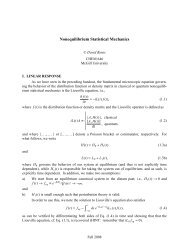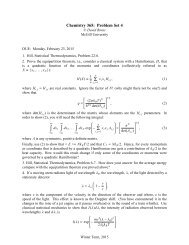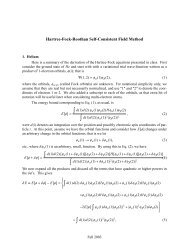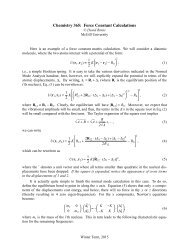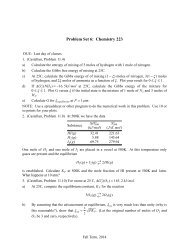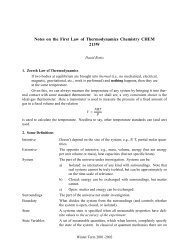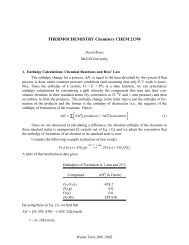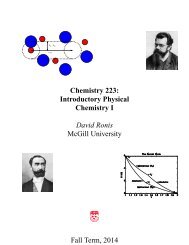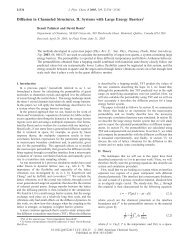<strong>Free</strong> <strong>Energy</strong> -6- Chemistry 2232.1. Coupled ReactionsIn some cases, the direct formation of a certain compound by direct reaction is thermodynamicallyforbidden. An example is the formation of titanium tetrachloride 1from common TiO 2 ore; i.e.,TiO 2 (s) + 2Cl 2 (g) → TiCl 4 (l) + O 2 (g).It turns out that ∆G =+152. 3kJ/mole. Nonetheless, we can make the reaction go by coupling itto one which pulls it along. For example, suppose we use the produced oxygen to burn carbon;i.e.,C(s, graphite) + O 2 (g) → CO 2 (g),where here ∆G =−394. 36kJ/mole. The free energy change for the coupled processes is -394.36+152.3 = -242.1 kJ/mole, <strong>and</strong> thus the coupled reaction can proceed. The burning carbon suppliesthe needed free energy to make the desired reaction work.2.2. General Tr endsFor this discussion, we will consider systems were the reactions take place at a fixed temperature<strong>and</strong> pressure; as such, the direction of change is determined by∆G =∆H − T ∆S,where ∆H <strong>and</strong> ∆S are the enthalpy <strong>and</strong> entropy change for the process, at the actual temperature<strong>and</strong> pressure. As we have said, for constant pressure <strong>and</strong> temperature processes, ∆G
<strong>Free</strong> <strong>Energy</strong> -7- Chemistry 2233.1. <strong>Thermodynamic</strong>s of Chemically Reacting SystemsAvery important example of thermodynamic equilibrium is that of chemical equilibriumat constant pressure <strong>and</strong> temperature. Consider the following general chemical reaction:2A + B → ← 3C + D.The chemical equation imposes a strong constraint on the changes in the numbers of moles ofeach component; for the forward reaction, each time a mole of B reacts, 2 of A are used up <strong>and</strong> 3of C <strong>and</strong> one of D are produced. Mathematically,dN A−2= dN B−1= dN C3= dN D1≡ dξ , (21)where the extent of the reaction is characterized by the quantity ξ (the Greek letter, pronouncedkse) called the progress variable. For an arbitrary chemical reaction involving r chemical components,the last expression generalizes todN 1ν 1= ... = dN rν r≡ dξ , (22)where ν i is the stoichiometric coefficient for the i’th component in the reaction (by convention, itis negative for reactants). This is just a mathematical formulation of the law ofdefinite proportionsdue to Joseph Proust, 1806, who wrote:"I shall conclude by deducing from these experiments the principle I have establishedat the commencement of this memoir, viz. that iron like many other metals issubject to the law ofnature which presides at every true combination, that is to say,that it unites with two constant proportions of oxygen. In this respect it does not differfrom tin, mercury, <strong>and</strong> lead, <strong>and</strong>, in a word, almost every known combustible."One can easily relate the actual amounts of compounds present at any stage of the reactionimply by integrating Eq. (22); i.e., N i = N (0)i + ν i ξ ,where N (0)i is the amount of compound ipresent when ξ = 0, i.e., at the start of the reaction.For constant temperature <strong>and</strong> pressure <strong>and</strong> total mass (for each element) conditions, thereaction can proceed until the Gibbs free energy is a minimum with respect to all allowed variationsin the state of the system. By knowing the amounts of the various compounds in terms of ξit is easy to express the Gibbs free energy in terms of ξ using Euler’s theorem (cf. Eq. (17)):where µ i is usually a function of ξ as well.⎛ ∂G ⎞G(ξ ) = Σ N i =i ⎝ ∂N i ⎠Σ(N (0)i + ν i ξ )µ i ,T ,P,N j≠iiFor fixed total mass, temperature, <strong>and</strong> pressure, the only variations which can be consideredare those which change ξ . Hence, we could use the last equation to plot G(ξ )versus ξ ;i.e.,the reaction moves either to the right or left until G(ξ )isaminimum. Instead of determining theequilibrium point graphically, wecan use calculus. We know that G can be a minimum withrespect to changes in the progress variable only if⎛ ∂G ⎞= 0 (23)⎝ ∂ξ ⎠ T ,P,NtotalFall Term, 2014




